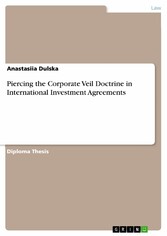Piercing the Corporate Veil Doctrine in International Investment Agreements
von: Anastasiia Dulska
GRIN Verlag , 2018
ISBN: 9783668716377
, 58 Seiten
Format: PDF
Kopierschutz: frei
Preis: 18,99 EUR
eBook anfordern 
Mehr zum Inhalt

Piercing the Corporate Veil Doctrine in International Investment Agreements
Diploma Thesis from the year 2017 in the subject Law - Miscellaneous, grade: 1.7, Humboldt-University of Berlin (International Dispute Resolution Master of Laws (LL.M.) Programme), course: International Investment Arbitration, language: English, abstract: The piercing the corporate veil in ISDS plays a twofold role. From the investors' perspective, it is instrumental if a tribunal can ignore the difference between the legal personality of the company in which they invested in and the shares that they hold. Per contra, States also invoke this doctrine by trying to convince a tribunal to look at the true personalities involved and not to allow an investor to hide behind the veil of the different legal personalities. To address these competing interests, the author of this Master Thesis in Chapter II intends to analyse the characteristic pattern and standing of shareholders in bringing indirect claims aimed to persuade the tribunal to ignore the difference between the legal personality of a company and its shareholders and to look at the true interests at stake instead. In Chapter III, the applicability of the piercing the corporate veil doctrine will be approached from the States' perspective and when they invoke the denial of benefits clauses. On the basis of the foregoing, this Master Thesis purports to address the intersection between the jurisdiction of the arbitral tribunal in ISDS and the concepts of investor and investment underlying the application of the piercing the corporate veil doctrine. By doing so, the author of this Master Thesis explores the provisions of IIAs commented on by authoritative treatises, contemporary views embodied in articles, and jurisprudence of international investment treaty tribunals. In order to arrive at its findings and conclusions, this Master Thesis utilizes the method of description, method of conceptual analysis, comparative method, and method of evaluation.









